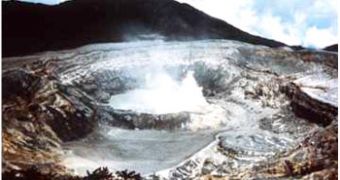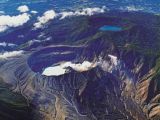There are 112 active or inactive volcanoes in Costa Rica, but Poas, 2,700 m (9,000 ft) tall, is extremely unusual. It is not the most active (this being Arenal, 1,500 m/5,000 ft tall) nor the tallest (this being Irazu, 3,400 m/11,330 ft tall), but it has two craters: an active one, while the other holds a lake surrounded by a lush jungle. Poas is the only place on Earth where lakes of LIQUID SULFUR can be found!
The eruptions of the Poas volcano are characterized by the abundance of sulfur. Sulfur is common in active volcanoes, but usually is present crystallized and yellow, a result of condensation. Liquid sulfur can be found as lava droplets. This emerges from solid sulfur which at 112o C fusions, turning liquid, like in Japonia (Siretoko-Iosan), Hawaii (Mauna Loa), Galapagos (Azufre) and Chile (Lastaria). This liquid sulfur results from remobilizing and fusioning of fumarole-originated sulfur deposits, due to the rise of temperature during a period of intense magmatic activity.
Poas' last important eruption took place between 1953-1955. The successive explosions formed a central crater, turned into a lake with hot water (40-60o C) and extremely acid (pH < 0.1) by 1965. The refilling of the lake was made regularly by rainfall and condensing water vapors emitted by the fumaroles (volcanic holes from which vapor rises) from the bottom of the lake.
Between 1987 and 1989, lake's levels dropped by 32 m (106 ft) and in the southeastern part of the lake a series of tiny "volcanoes" emerged, 2-3 m (6-10 ft) tall, made of yellow sulfur. In time, they turned into brown and boiling liquid sulfur sloughs. The small cones and their craters evolve continuously, some disappearing with the rainfall and reappearing as larger and more stable sloughs. In April 1989, the lake level dropped dramatically, and the bottom was made by several sloughs of persistent mud.
The small "volcanoes" are still active, emitting bubbles of solid yellow-green sulfur. Some fumaroles emitting orange vapors still persist, erupting violently gases that pulverize the bottom of the lake.
How does the sulfur form? The hydrogen sulfide and sulfur dioxide going to the surface from the inner volcano react in the acid water, deposing sulfur (the other product of the reaction is water). The sulfur deposes on the bottom of the lake or mixes with the sediments. As much as water was abundant, sulfur was maintained under the boiling point of the water (100o C) and that of the fusion for sulfur (112o C). The drying of the lake at the beginning of 1989 raised the temperature of the sediments located near the fumaroles, and caused the fusion of a large amount of sulfur. The sulfur sloughs seethe at 116o C, but the boiling point of the sulfur is 444o C.

 14 DAY TRIAL //
14 DAY TRIAL // 
